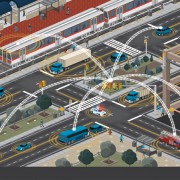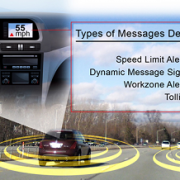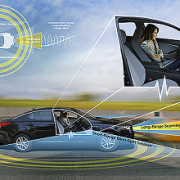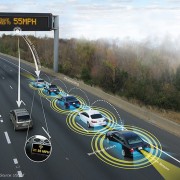Burney Simpson
The cost to deploy a single Vehicle-to-Infrastructure (V2I) roadside site could average over $50,000 but the costs for installing a national network of sites remains unclear, according to a General Accountability Office (GAO) report.
In addition, the development of a national V2I and Vehicle-to-Vehicle (V2V) infrastructure faces a number of challenges, topped by the need for greater data communication capabilities to handle the system’s Wi-Fi needs.
The GAO released last month “Intelligent Transportation Systems: Vehicle-to-Infrastructure Technologies Expected to Offer Benefits but Deployment Challenges Exist.” (Visit here for a summary).
The average cost of a single V2I site could reach $51,650 which would cover planning, equipment, installation, connectivity, and signal upgrades, the GAO determined. That would not include routine maintenance, staff training, equipment replacement, and security costs. A device might need to be replaced every five to 10 years.
The largest cost by far would be for backhaul, which covers the establishing of communication connectivity between the roadside unit and back offices or traffic management centers, along with fiber optic cables, sensors and relays. The GAO broke down the average costs as:
Planning & design: $6,650
Equipment: $7,450
Installation: $3,550
Backhaul: $30,800
Signal upgrades: $3,200
The single site cost can’t be extrapolated to a local, state, or national cost because “current cost data for V2I technology are limited due to the small number of test deployments thus far,” the GAO reports.
For instance. test bed deployments have varied in size, and different applications – a busy four-way intersection vs. a single-lane curve speed warning – may require different equipment.
One of the goals of the U.S. Department of Transportation’s just begun Connected Vehicle Pilot Deployment Project is to determine cost estimates for 56 V2I applications in three locations — New York City, Tampa, and Wyoming.
The payoffs on this investment could be huge. Since 2011, Japan has installed
about 55,000 pieces of V2I equipment on local roads, and 1,600 pieces on expressways, the GAO reported. Japan claims it has cut accident rates and reduced congestion which brought lower greenhouse gas emissions.
In the U.S., an installed V2I and V2V system could prevent 59 percent of single-vehicle crashes and 29 percent of multi-vehicle crashes, which engender costs of more than $200 billion annually, according to the Federal Highway Administration.
DSRC CHALLENGE
The biggest challenge facing the rollout of V2I and V2V technology is the capability of the radiofrequency spectrum that is now devoted to transportation safety communications, according to a survey of the 21 subject matter experts that contributed to the GAO study.
In brief, the 5.9 Gigahertz (GHz) band was set aside for Dedicated Short-Range Communications (DSRC) systems, a wireless technology that allows vehicles and infrastructure to communicate over a range of about 1,000 feet, the GAO reports.
A V2V-equipped vehicle can use DSRC to share data about 10 times per-second on its speed, position, heading, acceleration, size, and braking with surrounding vehicles and road infrastructure.
The DOT has insisted the 5.9 band remain exclusive for V2I, V2V and other traffic-oriented communications. (For its part, Japan tested its 700 MHz band for sharing capability and decided to keep it devoted to V2I and V2V communications.)
However, growing demand for spectrum for Wi-Fi from consumers, businesses, and state and local governments has spurred the Federal Communications Commission to investigate whether it’s feasible to share the 5.9 band. The FCC oversees spectrum use by nonfederal users.
The GAO found that there are two important non-government efforts looking into technology that would allow for sharing of the 5.9 band:
- Toyota, Denso, Qualcomm division CSR Technologies and other firms have been working since 2013 with the Institute of Electrical and Electronics Engineers (IEEE) DSRC Tiger Team;
- Cisco Systems, the Alliance of Automobile Manufacturers, and the Association of Global Automakers are in the midst of testing “listen, detect, and avoid” protocol. In May, these three, along with GM and Toyota, met with the FCC and predicted that feasibility testing of the technology could be completed by the end of 2015.
GM has publicly committed that its 2017 Model Year Cadillac CTS vehicles will have DSRC technology. That would translate into DSRC-capable vehicles for sale to the public as soon as the third quarter of 2016.
The GAO wrote its report at the request of Rep. Larry Bucshon, an Indiana Republican, Rep. Barbara Comstock, a Virginia Republican, and Rep. Daniel Lipinski, an Illinois Democrat. Bucshon is on the House Energy & Commerce Committee; Comstock and Lipinski are on the House Transportation & Infrastructure Committee.
Installing a V2I and V2V infrastructure will be a huge task. A number of DOT pilots now in the works won’t be done until 2020, and the agency estimates that even by 2025 only 20 percent of intersections will be V2I capable. For now, the goal is to have 80 percent of intersections V2I capable by 2040.





